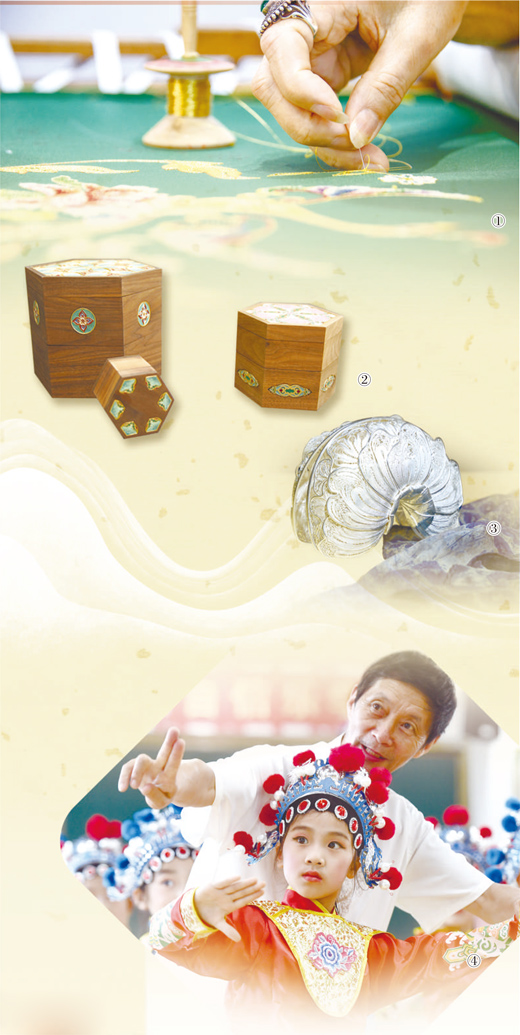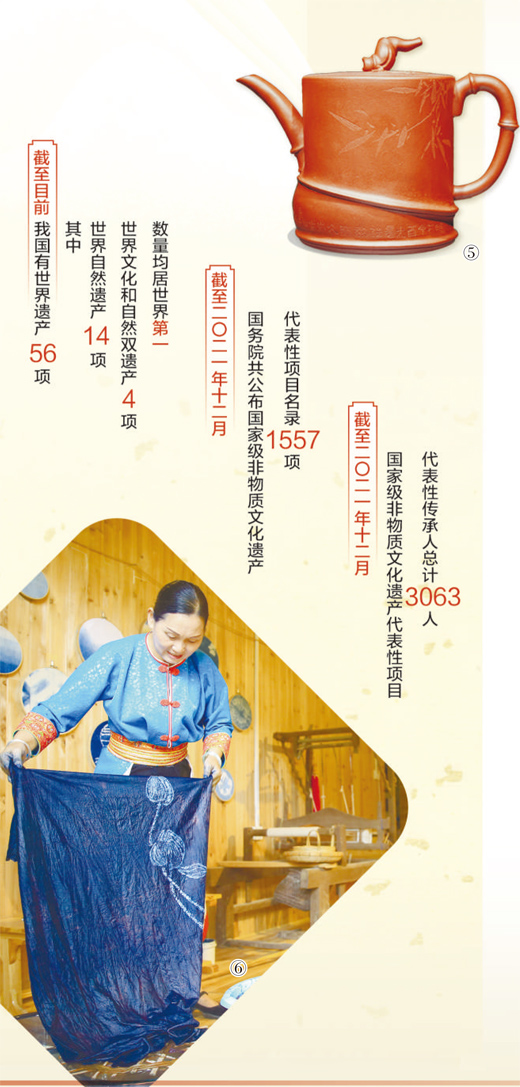Inheriting innovation and feeling the beauty of intangible heritage (special report on cultural and natural heritage day)

Figure ①: At the preferential exhibition season of Hubei intangible products, the staff are showing the skills of Han embroidery.
Photo by Wu Zhizun (Xinhua News Agency)
Figure 2: Cloisonne works.
Photo by Du Lili
Figure ③: Silver filigree works.
Photo by Du Lili
Figure ④: Students of shanggao county Experimental Primary School in Yichun City, Jiangxi Province are learning Peking Opera performances.
Photo by Zhou Liang (image China)

Figure ⑤: teapot.
Photo by Du Lili
Figure ⑥: At Huayao Wenchuang Base in Baishuidong Village, Shaoyang, Hunan Province, staff are showing non-legacy cultural and creative products.
Zeng Yongshe (image China)
Source: Ministry of Culture and Tourism, National Forestry and Grassland Bureau.
General Secretary of the Supreme Leader pointed out: "Historical and cultural heritage carries the genes and blood of the Chinese nation, which belongs not only to our generation, but also to future generations." June 11th is China’s Cultural and Natural Heritage Day in 2022. In recent years, China has effectively strengthened the protection of cultural relics and promoted the activation and utilization of intangible cultural heritage. Whether it is a cultural relic program screen network or a young person who is not a good thing; Whether it’s cross-border innovation of old crafts or entering the school classroom … … Nowadays, cultural heritage is increasingly connected with modern life, blooming charming brilliance and embracing a broader future.
Today, we turn our attention to the vivid practice in the field of cultural heritage, feel the vitality and strengthen our cultural self-confidence in guarding and advancing with the times from generation to generation.
— — Editor
Zaoyang coarse cloth making skills are integrated into current costume design.
Old cloth weaves modern new ideas
Our reporter Li Xia
A polished wooden shuttle passed through the upper and lower rows of cotton yarn, and the left hand held the loom and pulled it hard into the arms, making a crisp crash. Suddenly, the right hand shuttle flew to the left hand accurately from between the cotton threads, and then took the loom and sent it to the arms. There were two crisp crashes again. Between the warp and weft, a piece of cloth with clear lines gradually takes shape. Wang Yilin, the inheritor of Zaoyang coarse cloth making skills, is 95 years old, but once he sits in front of the loom, his hand movements are still dazzling.
Zaoyang coarse cloth making technique is a traditional homespun textile technique spread in Zaoyang and its surrounding areas in Hubei Province. In May 2021, it was listed in the fifth batch of national intangible cultural heritage representative projects. Zaoyang coarse cloth is made of local high-quality cotton, woven by wooden pedal loom, and hand-made through 17 processes, such as embossing, bouncing, cotton sliver rubbing, spinning, warp drawing, button threading, longitudinal threading, weaving and dyeing. It is full of colorful, simple and bright patterns, and simple and unrestrained style.
As a result, the old man’s son Liu Dayou and his daughter-in-law Zhang Qihua became the "defenders" of Zaoyang’s coarse cloth making skills. The couple founded the brand "Baibutang" in Wuhan, and developed the traditional intangible skills into a modern textile brand, and successively established eight non-genetic workshops and studios in Wuhan and Zaoyang. Every year, we provide free training and impart textile skills to the society, and jointly establish an entrepreneurship training base with the Women’s Federation to provide women with employment opportunities.
To inherit and innovate, Zhang Qihua put forward the research and development concept of "old cloth and new work". Baibutong cooperated with wuhan textile University, Hubei University of Technology, Xiangyang Vocational and Technical College and other institutions. Zaoyang coarse cloth production was combined with modern technology, and the design, color and style were innovated, and the weaving method was improved, so that the intangible skills could be integrated into modern life. Not long ago, in the first intangible fashion show in Hubei Province, 17 sets of Zaoyang coarse cloth intangible fashion made by Baibutang were amazed by the audience with their unique production technology, ingenious integration of intangible elements and modern clothing.
Zaoyang coarse cloth is a textile, and cotton is the source of its creation. This year, Baibutang also cooperated with Hubei Academy of Agricultural Sciences to jointly develop and cultivate colored cotton and further innovate products. At present, there are 26.7 mu of colored cotton planted in the experimental field of Hubei Academy of Agricultural Sciences. Next year, Baibutang plans to put colored cotton planting projects into suitable villages to contribute to the development of rural economy.
The film "Tian Gong Su Zuo" shows its charm.
Light and shadow tell a thousand years of ingenuity
Our reporter Wang Weijian
Picking up carving knives and scissors in both hands, after dozens of processes such as kneading, cooking, coloring and modeling, everything in the camera, a vivid cartoon image snack appears on the dishes … … The 71-year-old Dong Jiarong is the "top card" of the Soviet-style shipping point, and once won the gold medal in international competitions on behalf of China. However, after an illness more than ten years ago, his hands have been shaking badly and he has never done a boat trip again. Four years ago, Dong Jiarong was invited to participate in the filming of the first documentary film "Tiangong Su Zuo" with the theme of non-legacy in Suzhou, Jiangsu Province. He was so happy that he stayed up all night and picked up his old skills again.
Li Hong, director of the Intangible Heritage Department of Suzhou Culture, Radio, Film and Tourism Bureau, introduced that in 2014, Suzhou joined the UNESCO "Creative City Network" and became the global "handicraft and folk art capital". Taking this as an opportunity, Suzhou Municipal Bureau of Culture and Tourism cooperated with Suzhou Radio and Television General Station to launch the documentary film "Tiangong Su Zuo". In 90 minutes, nine Suzhou traditional crafts, such as Su-style boat spots, Song Jin, nuclear carvings, lanterns, and Xiangshan traditional architecture, have appeared one after another, and 12 Su Zuo inheritors with stunts have turned into "protagonists" on the screen, showing a beautiful feast. Since its premiere, Tiangong Su Zuo has been shown in 56 cities across the country in turn. Soon, the film will also land in mainstream cinemas in new york, Toronto, Sydney and other places around the world.
What kind of sparks will ancient intangible art collide with modern light and shadow technology?
For the non-genetic inheritors in the film, this is not only an unforgettable "electric shock" trip, but also strengthens their confidence in the development and inheritance of the intangible heritage.
Excellent Jiangsu and Zhejiang silk is used, gardens and pavilions are tied, and Wumen ink and painting is danqing. Rows of Su lanterns with rich history and culture dress up the night in colorful colors. In focus plane, Wang Xiaowen, a national intangible heritage inheritor of Suzhou Lantern Festival, is immersed in the colorful world he created. But outside the screen, this intangible skill that has been passed down for thousands of years was once endangered. Wang Xiaowen recalled that with the rapid development of economy, Suzhou lanterns gradually faded out of people’s sight. Before that, only a few people in Suzhou could produce high-level lanterns. However, with the release of "Tian Gong Su Zuo", many young people came here, and nearby primary and secondary schools also invited him to give lectures. Today, Wang Xiaowen has 28 regular lectures every week.
For the audience, "Tian Gong Su Zuo" is like a non-legacy exhibition hall, telling a warm and moving Suzhou non-legacy story among the oars and lights. "I want to go to Suzhou to learn crafts after reading it. Movies can make more young people love it." An audience member said excitedly.
Innovative exhibition mode of Tianjin Heping District Intangible Heritage Exhibition Hall
The ancient charm of science and technology is not a legacy.
Our reporter Wu Shaomin
The founding time is dotted with axes and places, and the intangible items are marked in detail one by one … … On the second floor of the West Zone, North Building, Minyuan Square, Fifth Avenue, Tianjin, the Heping District Intangible Cultural Heritage Exhibition Hall is quiet and quiet, creating an intangible world with great movement.
"These three bronze statues are the three founders of the national intangible cultural heritage project: Mr. Gao Guiyou, the founder of Goubuli Steamed Bun making skill, Mr. Pang Henian, the founder of Laomeihua handmade shoemaking skill, and Mr. Wang Dianying &hellip, the inheritor of China classical tricks; …” Entering the exhibition hall, the profound non-legacy culture is coming. Liu Qian, the person in charge of the Heping District Intangible Cultural Heritage Exhibition Hall, introduced that the exhibition hall is divided into four parts: Jinwei, Medical Way, Baixi and Gongqiao, covering all the intangible cultural heritage projects in Heping District.
"The rolling film at the window is made up of more than 100 real historical photos. Being in the carriage, I feel the intangible heritage of traveling through time and space … …” Accompanied by the ringing of the bell, I boarded the "non-legacy" tram with a history of 100 years, with the display screen as the window glass. The bustling and noisy street scenes of old Tianjin in the 1920 s flashed, and many old Tianjin brands such as department stores and Quanyechang were presented in front of me, with a long aftertaste of Tianjin shouts.
In the non-legacy "interactive area" of the exhibition hall, the audience can experience the non-legacy charm by means of AR (augmented reality), VR (virtual reality) and other technical means. "The exhibition uses the combination of panels, physical exhibitions, video playback, live demonstration embedding and modern scientific and technological means to make the audience feel the beauty of the legacy." Li Kang, member of the Standing Committee of Heping District Committee and Minister of Propaganda Department, said that everyone is a practitioner and inheritor of the legacy, and the serious face of the audience will make the legacy shine again.
Non-genetic inheritance is an important link. The exhibition hall holds non-genetic inheritance activities from time to time, and children will sit around and listen to the inheritors of non-legacy projects such as Liu’s carving and inlaying craft bird cage, northern printing and carving skills, and hand-made live ball glass bottle making skills, telling non-legacy stories. Select some non-legacy projects, encourage college students to combine non-legacy elements and the trend of the times to innovate boldly and bring the products of the competition to the market; Students have one-on-one in-depth exchange and study with the inheritors of non-legacy projects to stimulate whimsy … … Intangible cultural heritage has a new vitality in its inheritance.
"In the near future, we will carry out ‘ People’s non-legacy and people’s sharing ’ Cultivate a series of activities such as small inheritors, such as inviting Zong Zhaorui, a representative project of municipal intangible heritage, to make line incense and teach intangible skills on the spot, so that everyone can close the distance with intangible heritage. " Liu Wei said.
Coordinator of this edition: Yang Xuan, Zhi Chunli
Layout design: Zhang Fangman